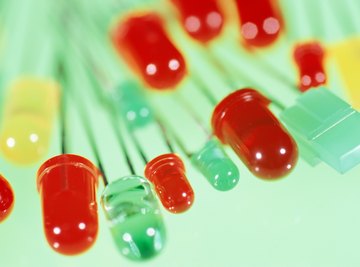
Light-emitting diodes (LEDs) are bright, inexpensive and available in many colors. Connect LEDs in series to make a string of lights that you power from your USB socket. Use these LED strings to illuminate your keyboard when you're working in the dark, or make mini holiday decorations for your office or home workstation. LEDs are cheap and easy to find in stores. You'll also need a few other components including a resistor, wire and solder, and equipment such as a soldering iron. You can obtain all of these from an electronics hobby store.
- Stable, heatproof workspace
- 5 or 6 feet of flexible single-core insulated wire (bell wire)
- Wire cutters and strippers
- Solder
- Soldering iron
- 10 LEDs
- Multi-arm hobby vise ("helping hands" tool)
- One megaohm (1K) resistor
- Cable with male USB plug
- Multimeter
- Hot glue gun (optional)
- Electrical tape (optional)
Your computer must be turned on for the lights to work.
Do not leave a hot soldering iron unattended. Take great care when handling a soldering iron as it can cause serious injury. Wash your hands after handling solder.
Cut nine sections of wire 2 or 3 inches in length. Strip away 1/16th inch from both ends of each piece of wire. Tin all of the bare ends -- this means to coat them with solder. Heat the wire with the tip of the soldering iron, then apply a very small dab of solder and allow it to form a thin coating all over the bare metal.
Solder a piece of wire to each leg of five of the LEDs. The bare end of the wire should point towards the base. The end of the wire should be as close to the base of each LED as possible. It is often helpful to secure the wire or the LED in the helping hand tool so you have your hands free for the solder and soldering iron.
Solder the free end of each piece of wire to the unsoldered LEDs. You must orient the LEDs correctly, as an LED is a polarized component. If you solder even one LED the wrong way round, your lights won't work. Each LED has one longer and one shorter lead. You need to make sure that the long lead of one LED is connected to the short lead of the next LED. You should be left with a string of LEDs with a bare LED lead at each end.
Trim the leads of the resistor so that around a quarter of an inch is left at each end. Solder one lead to the long LED lead that remains unsoldered. Cut a section of wire around three feet in length; strip and tin one end, then solder it to the other unsoldered LED lead.
Cut one end off the USB cable, ensuring that the remaining end is a male USB plug. Strip away a quarter-inch of the outer casing. Inside the cable there will be two or four wires. Identify the five volt (+5v) and zero volt (GND) wires. It may be obvious which is which -- some cables have a red (+5v) and a black (GND) cable. If you can't tell visually which cable is carrying five volts, use the multimeter. Carefully separate all the wires to avoid the possibility of a short. Insert the USB plug into the USB connection of your computer. Probe the ends of the wires to find the +5v and GND wires. Disconnect the USB cable from the computer before you continue working.
Solder the free lead of the resistor to the +5v wire of the USB cable. Solder the free end of the long length of wire to the GND wire inside the USB cable. Trim all of the LED leads. Gently twist the long wire and the LED string together. Test the lights by connecting the USB cable to one of your computer's USB ports; all the LEDs should light.
Cover any bare wire with insulation. Wrap any exposed leads with electrical tape. For the backs of the LEDs, you can apply a dab of hot glue instead of using tape.
Things You'll Need
Tips
Warnings
References
Tips
- Your computer must be turned on for the lights to work.
Warnings
- Do not leave a hot soldering iron unattended.
- Take great care when handling a soldering iron as it can cause serious injury.
- Wash your hands after handling solder.
About the Author
Clare Edwards has been providing Internet content since 1998. She has written and translated for a variety of markets: everything from technical articles to short fiction and essays on alternative spirituality. She holds a certificate of higher education in electronics and audio arts from Middlesex University.
Photo Credits
Stockbyte/Stockbyte/Getty Images
